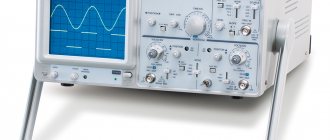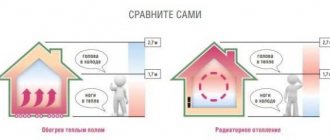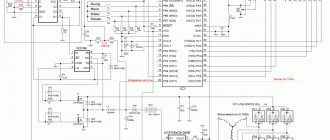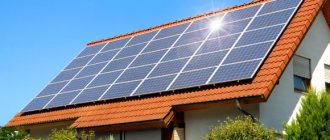Level, level, plane builder - with the advent of the “laser” prefix, these useful devices for precise orientation in space acquire a modern sound and at the same time a significant cost.
Despite the fact that any of the devices can significantly make the life of a builder, repairman, or simply a thrifty and homely owner, many are in no hurry to purchase “professional” models, mainly because of the high price.
However, expensive equipment for one-time use (for example, leveling walls) can be completely replaced with a homemade device. To do this, you must first understand the structure of the level or plane builder.
What is a laser level
A laser level or level is a device that constructs light lines on vertical or horizontal planes of a room. The purpose of the device is to speed up and ensure high accuracy of marking walls, floors or ceilings of residential or public premises. Traditional methods of marking work require a lot of time. Plumb lines and bubble building levels are used, which can provide sufficient measurement accuracy, but allow for high errors and instability of readings. This is especially true in large rooms with uneven surfaces, where it is very difficult to apply an even line using traditional methods. You have to pull the cords, repeatedly checking their position, monitoring their condition, whereas the laser level only needs to be turned on. These operations require an assistant, and the laser level can be easily operated by one person.
The accuracy and speed of marking greatly increases work productivity and ensures high quality finishing or equipment installation.
The operation of the device is based on the use of one, two or three laser beams and a scanning or focusing system, depending on the type of design. A beam of light emitted by a laser passes through a specific focusing system and shows a point, straight line or plane (one, two or three), allowing you to quickly and accurately mark the surface or start work directly along visible lines. The device is installed on a flat, dense area or on its own tripod, which ensures stability and immobility of the device.
For home and work
The main difference influencing the choice is not professional or amateur use, but the intention to use the device indoors or outdoors. In the first case, any laser level will meet the basic functional requirements.
In the open air, there is a need for additional sensors - sunlight makes the laser beam invisible, so an additional accessory is needed to obtain readings.
In amateur versions there is usually no need to select a cross laser that works with the sensor (only some models have this option), but if the level needs to be determined in a spacious, well-lit room, then it can come in handy.
Types of devices
There are three main groups of laser levels, differing from each other in purpose, design complexity and number of beams.
Point (axis builder)
The device is able to project a point without forming a straight line. To apply horizontal markings, you need to sequentially mark two points at different ends of the wall and draw a line between them or pull a cord.
A point has maximum clarity on a plane, so the range of action of axis builders is noticeably greater than that of other types
You have to perform some additional steps, which somewhat complicates the measurements, but the accuracy and ability to determine the distance using a laser rangefinder, as well as the presence of up to five beams (in the most advanced models), increases the accuracy of the work.
Crossliner (line builder)
This type of level allows you to build a light line on a plane. The beam is passed through a prism, which rotates it 120°, resulting in a straight thin strip appearing on the surface.
It is convenient to work with a crossliner when the planes are uneven, have complex terrain or many elements that make traditional marking methods impossible
Some models of such devices allow you to simultaneously obtain horizontal and vertical main lines, and up to 5 additional ones. The level's capabilities allow you not to apply any markings to the wall or floor, but to work directly along the projected light axes.
Rotary plane builder
In this case, it becomes possible to obtain one or more planes (usually one horizontal and two vertical).
The rotary level is indispensable when leveling the floor, pouring screed, installing stretch ceilings and other work with planes that require precision and high quality
A beam of light rotates around its axis, projecting a continuous strip of light around the source, building a plane. This allows you to determine the degree of slope of the floor or ceiling, and control the verticality of walls or partitions.
Static laser levels
Static levels project rays from their light source onto a system of prisms, resulting in an image in the form of a cross being formed on the surrounding surface. If the level has more than three laser LEDs, you can create projections of several planes, which is very useful when working on several surrounding objects simultaneously.
Technical characteristics of levels
There are a large number of models of laser levels of all types. They have certain technical characteristics that allow you to get a general idea of the capabilities of each device.
Basic indicators:
- measurement range. A parameter that determines the distance at which the beam of the device can be distinguished. It depends on the power of the light source. Some samples have a range of up to 300 m, but most levels operate at 20 m. The higher the range, the more capabilities the devices have, especially when working outdoors in bright lighting conditions;
- number of rays and their color. Most modern models of laser levels have 5 beams, but different options are possible. The more rays, the higher the capabilities of the device, which allows you to project openings, installation axes of door, window blocks or equipment. The devices have the ability to turn off beams that are not needed at the moment. The color of the beam determines its clarity and the ability to use it in bright lighting conditions (outdoors). There are devices with red or green beams. Red is considered less bright and distinct, green allows you to work outdoors. To enhance visibility, special glasses are used that cut off individual frequencies of the light wave and make it possible to clearly distinguish lines from levels;
- type of alignment and the ability to disable it. Defines the method for setting horizontal or vertical. There are devices with manual, pendulum and electronic installation types. The most convenient option is automatic leveling (leveling) of the plane, relieving the owner of the need to install manually. The permissible error reaches 5%, on some devices it is even less. If the deviation of the device from the horizontal exceeds 5%, an audible signal is given to warn of an installation failure. In such cases, you have to act manually. The ability to disable automatic installation, which is necessary when working on slopes, is also appreciated. Under such conditions, the device will not be able to independently provide horizontal position and will continuously signal that the position is violated, so the setting is turned off and the position is displayed manually.
When choosing a device, you should take into account the specifics of the upcoming work so that you can get the optimal result
- accuracy and measurement error. Laser levels have three levels of accuracy, corresponding to household, semi-professional and professional devices. The degree of permissible deviation from the true value decreases with increasing class of the device. Household devices have an error of 5–8 mm per 10 m, semi-professional devices have an error of 3–5 mm per 10 m, professional devices provide an accuracy of 0.5 to 3 mm per 10 m;
- Type of food. There are two options for powering devices - rechargeable and battery-powered. The first ones use rechargeable batteries like on mobile phones. They are more expensive, the operating time before recharging is about 20 hours, but the number of charging cycles is high. Battery-powered devices are cheaper; one set provides about 60 hours of continuous operation, but after that you will have to buy a new set;
- Dimensions and weight. The dimensions of laser levels are relatively small; individual devices differ significantly from other samples. The reasons for this difference lie in the design, capabilities and type of housing. Small and lightweight devices are considered the most successful, since they have to be transported along with a large number of other tools and devices. For home use, when there is no need to constantly carry a laser level from one place to another, a more massive device is suitable, although household samples are not large in size;
- housing protection class. The conditions for using the device may be different - high dust levels, when working in an open area, precipitation and mechanical damage are possible. The housing material is usually impact-resistant plastics. Falls from supporting platforms often occur, which poses a threat to the integrity of the device. The standard level of housing protection is marked IP54 and ensures safety in case of a fall, excludes the penetration of dust or moisture, and protects against other influences. For interior work, a lower level of protection is sufficient - IP20 or close to it.
Additional characteristics:
- fastening type. The level is installed on a horizontal plane. Additional supporting structures can be a tripod, a magnetic stand, some models have specially attached magnets to the body, allowing the device to be fixed to any steel element of the site. The simplest method of mounting is a hole in the housing, which allows you to put the device on a nail in the wall;
- presence of shock protection. To eliminate the possibility of destruction of the device, elastic damper pads are installed inside the case to soften shock loads;
- possibility of independent adjustment. The conditions for using laser levels are quite complex; sometimes the device settings get lost and require re-adjustment. Some samples have the ability to automatically regulate, you just need to turn on the debugging mode. This significantly saves time and does not distract the employee;
- fastening thread. This parameter is important when purchasing a tripod, since the thread on it must match the size of the device’s socket. If these values do not match, you need to purchase an adapter from one type of thread to another. When purchasing, it is important to know the thread parameters on the existing device.
To increase the range of the level, special devices are used - beam receivers. They double the working distance and provide clear projection visibility on surfaces.
Types of levels, their capabilities and price
By design, the level can be:
Optic
It is used for various geodetic works, during the construction and repair of roads.
Designed to determine the difference in height between points, as well as the distance between them.
Determination of angles of inclination and height differences is carried out using a graduated scale printed on the glass.
To correctly install the device relative to the horizon, a bubble level is used.
To dampen vibrations, as well as to ensure stability, such levels are equipped with a magnetic damper or an air compensator.
The cost starts from 8 thousand rubles.
Digital (electronic)
A modern geodetic instrument that takes readings with high accuracy using a special staff.
The design simultaneously combines an optical level, an electronic storage device, as well as built-in software that processes data.
The electronic level works quickly and eliminates operator errors.
To take measurements, you need to focus on the staff, and when you press a button, the device will display all the necessary values on the screen.
The cost of the simplest models starts from 80 thousand rubles.
Laser
Allows you to construct vertical, horizontal and inclined planes with high accuracy.
Some devices have a plumb line function, which allows you to measure angles of 45° and 90°.
Another name for this type of level is a laser construction level, due to its scope of application.
Laser levels, in turn, are divided into the following classes:
Positional (linear)
The most common type of level.
Through lenses and prisms, the light flux is refracted, and as a result, static lines are built, oriented in space with high accuracy.
Such plane builders have an opening angle of up to 110° - 130°.
They are used mainly indoors.
The cost starts from 2 thousand rubles.
More professional models will cost 7–8 thousand rubles.
Rotary
It is used mainly on open construction sites, as it has a long range, which is reflected in its cost.
The level forms a point due to the beam, which, through the rapid rotational movement of the mechanism, outlines the plane.
Cost – from 7 thousand rubles.
In sunny weather, the line outlined by the moving beam is often impossible to see.
For this reason, models with a radiation receiver, which is a separate electronic device, are used.
When the laser is pointed at the photocell of such a receiver, the device emits an audio or visual signal.
Spot
Emits a direct light beam, which, when intersecting with any object, forms a point on it.
The price of professional models starts from 6 thousand rubles.
A laser level that has the ability to project beams in all three planes is called a 3D level.
According to the method of setting the tool (type of alignment), laser levels are divided into:
• Manual – adjustment is performed by the operator using ordinary bubble-type levels located on the housing. Precise positioning is performed by screw verniers.
• Self-leveling - adjustments are made through various built-in mechanisms.
Another name is automatic level.
Thus, the electronic leveling system independently compensates for up to 15% of the error in deviation from the horizon by analyzing information from special sensors and subsequent adjustment by servos.
The pendulum compensation mechanically compensates for deviations of up to 5% using a built-in permanent magnet.
• Combined – uses several alignment methods simultaneously.
There are two types of laser levels based on the color of the beam:
• With green beam.
Used for outdoor work as the beam wavelength is 532 nm.
This color is not only better perceived by the eye, but is also capable of constructing planes at a distance of up to 1 km.
In bright sunlight, the beam is often impossible to see.
• With a red beam – used for indoor work.
The wavelength of 635 nm, depending on the specific model, provides a range of 10 – 500 m.
The laser device requires a power source to operate.
Most often it is a built-in or removable battery that requires periodic recharging.
Small devices that can fit in a pocket use disposable batteries to operate.
Most rarely you can find network options, the functioning of which requires their connection to a household electrical network.
Hydrostatic leveling is another accurate method of measuring elevation differences, used primarily in construction.
It requires a hydraulic level - a long transparent hose filled with liquid.
The measuring process is based on Pascal's law of communicating vessels and allows one to estimate the heights of objects that are not in direct visibility.
How to use the device
Let's look at the basic rules for using laser levels, which differ for different types of devices.
Point level
Before starting work, install the device on a flat horizontal platform. If it is possible to automatically adjust the position, the debugging mode is turned on and the horizontal adjustment is made. If this function is not available, a regular bubble level is used. Points are marked on the surface, which are either the centers of future holes, or define straight lines for subsequent work.
Crossliner
The device is installed and leveled horizontally. Lines are projected onto vertical or horizontal surfaces that determine the level of installation of various elements, the axis of laying tiles, etc. If necessary, two perpendicular lines are used, or one horizontal and two vertical, defining the dimensions of the opening or other element.
Rotary
Rotary models are used when installing planes - suspended ceilings, floor screeds, when gluing wallpaper and other work that requires the formation of a flat horizontal plane. The device is installed on a flat surface with the required height; if necessary, it can be suspended from the ceiling. The height of the rotation plane is set, aligned with the light line of the device, after which marking of walls or direct work is carried out.
The operating technique of the laser level is described in more detail in the user manual included with the device. It reflects all the subtleties, specific work methods, and safety requirements. In particular, it is necessary to avoid getting the beam into the eyes, since there is a serious danger of burning the retina or damaging the lens.











